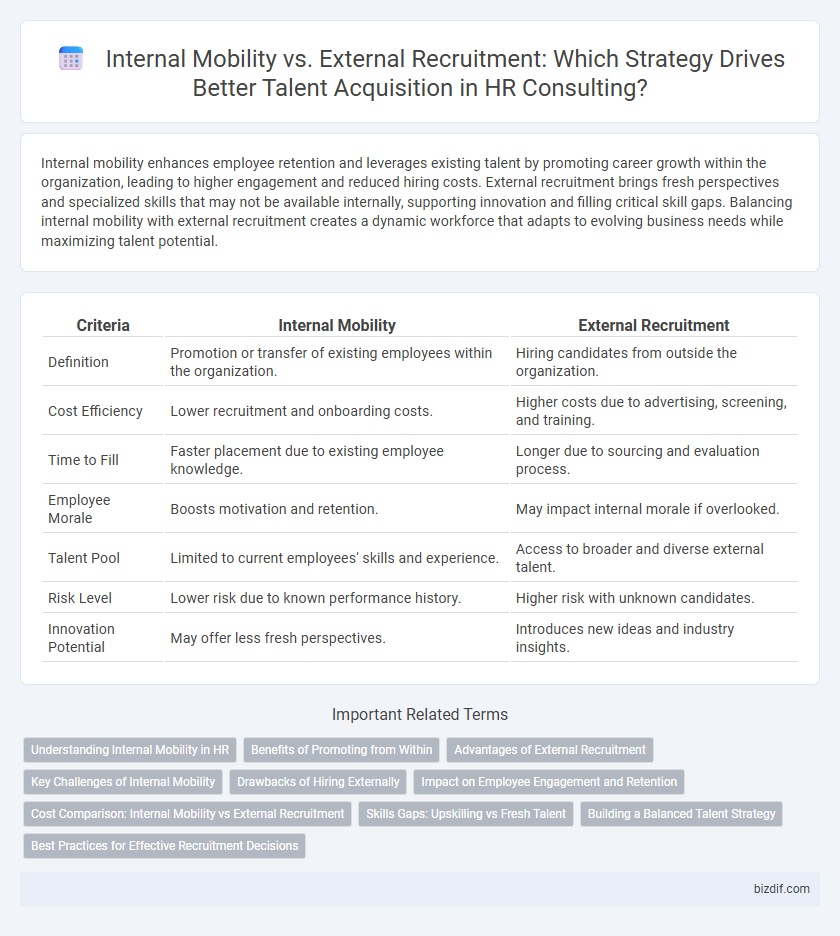Internal mobility enhances employee retention and leverages existing talent by promoting career growth within the organization, leading to higher engagement and reduced hiring costs. External recruitment brings fresh perspectives and specialized skills that may not be available internally, supporting innovation and filling critical skill gaps. Balancing internal mobility with external recruitment creates a dynamic workforce that adapts to evolving business needs while maximizing talent potential.
Table of Comparison
| Criteria | Internal Mobility | External Recruitment |
|---|---|---|
| Definition | Promotion or transfer of existing employees within the organization. | Hiring candidates from outside the organization. |
| Cost Efficiency | Lower recruitment and onboarding costs. | Higher costs due to advertising, screening, and training. |
| Time to Fill | Faster placement due to existing employee knowledge. | Longer due to sourcing and evaluation process. |
| Employee Morale | Boosts motivation and retention. | May impact internal morale if overlooked. |
| Talent Pool | Limited to current employees' skills and experience. | Access to broader and diverse external talent. |
| Risk Level | Lower risk due to known performance history. | Higher risk with unknown candidates. |
| Innovation Potential | May offer less fresh perspectives. | Introduces new ideas and industry insights. |
Understanding Internal Mobility in HR
Internal mobility in HR refers to the strategic process of promoting or transferring existing employees within an organization to fill open roles, enhancing talent retention and employee engagement. This approach leverages institutional knowledge, reduces recruitment costs, and shortens onboarding time compared to external hiring. Fostering a culture of internal mobility supports career development and aligns workforce capabilities with evolving business needs.
Benefits of Promoting from Within
Promoting from within enhances employee morale and boosts retention by demonstrating clear career progression paths. Internal mobility reduces recruitment costs and shortens onboarding time since existing employees already understand company culture and processes. Leveraging internal talent also fosters organizational knowledge continuity and drives stronger team cohesion.
Advantages of External Recruitment
External recruitment offers access to a broader talent pool, enabling companies to find specialized skills and fresh perspectives not available internally. It supports diversity enhancement by bringing in candidates from different backgrounds and experiences, which can strengthen innovation and problem-solving. Hiring externally can also help address skill gaps quickly, ensuring the organization stays competitive in a rapidly changing market.
Key Challenges of Internal Mobility
Internal mobility faces key challenges such as skill gaps when current employees lack qualifications for new roles and resistance to change within organizational culture. Limited internal talent pools can hinder filling specialized positions, slowing down project timelines and affecting business agility. Tracking employee career development and aligning it with strategic workforce planning require robust HR systems, often lacking in many companies.
Drawbacks of Hiring Externally
External recruitment often results in higher costs due to job advertising, recruitment agency fees, and extended onboarding time. New hires may face cultural misalignment and longer adjustment periods, which reduce initial productivity and increase turnover risk. Missing internal candidates also diminishes employee motivation and limits the utilization of existing organizational talent pools.
Impact on Employee Engagement and Retention
Internal mobility significantly enhances employee engagement by providing clear career progression opportunities, fostering a sense of loyalty and motivation. It reduces turnover rates as employees feel valued and invested in, leading to higher retention compared to external recruitment. External recruitment, while bringing fresh skills, can disrupt team dynamics and often results in longer onboarding periods, potentially impacting overall employee morale.
Cost Comparison: Internal Mobility vs External Recruitment
Internal mobility reduces hiring costs by leveraging existing employee skills and minimizing expenses related to job advertisements, recruitment agencies, and onboarding. External recruitment often incurs higher costs due to extensive sourcing, assessment processes, and longer time-to-fill metrics, which can impact overall productivity. Companies prioritizing internal mobility benefit from faster placement times and lower recruitment overhead, translating into significant cost savings.
Skills Gaps: Upskilling vs Fresh Talent
Addressing skills gaps through internal mobility accelerates employee development by focusing on upskilling existing talent, enhancing organizational knowledge retention and culture alignment. External recruitment introduces fresh talent with specialized skills and innovative perspectives, potentially filling immediate competency voids but may require longer onboarding periods. Strategic HR consulting balances these approaches by assessing current workforce capabilities and future needs to optimize talent acquisition and development.
Building a Balanced Talent Strategy
Internal mobility leverages existing employee skills and organizational knowledge, reducing time-to-fill positions and improving retention rates by fostering career development. External recruitment injects fresh perspectives and specialized expertise, essential for innovation and filling skill gaps that internal talent cannot address. A balanced talent strategy integrates both approaches, optimizing workforce agility and aligning talent acquisition with long-term business goals.
Best Practices for Effective Recruitment Decisions
Internal mobility enhances employee engagement and reduces onboarding time by leveraging existing talent familiar with company culture and processes. External recruitment introduces fresh perspectives and specialized skills that may not be available internally, expanding the talent pool for strategic roles. Combining data-driven assessments, clear competency frameworks, and aligned career development plans ensures balanced, effective recruitment decisions that support organizational growth.
Internal Mobility vs External Recruitment Infographic

 bizdif.com
bizdif.com